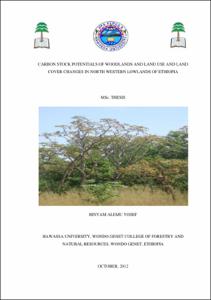Resource information
A major problem being faced by human society is the rising of global temperature mainly due to human activity that emit carbon dioxide to the atmosphere. The problem of increasing atmospheric carbon dioxide can be addressed in a number of ways. One of such actions is forestry development and forest management undertakings. Sustainable forest management and development is believed to be an asset for increasing societal adaptive capacity to climate anomalies. This paper examined the potential of the dry western woodlands of Ethiopia for carbon sequestration in response to woodland cover changes. The study was based on the assumption that increasing societal adaptive capacity is possible through asset building from financial earnings obtained from carbon trading and non-timber forest products, especially gum and resin from Boswellia papyrifera woodland. GIS and RS were used to determine the LULCC. To
estimate the amount of carbon stocked in dry land forests; vegetation inventory including dead wood, litter and herbaceous biomass collection were conducted in the 36 sample plots across the three districts of the study area namely: Kafta-Humera 17 plot, Metema 9 plot and Sherkole 10 plot. The sample plots were taken in transects line method in the two categories of woodlands, untapped and tapped Boswellia papyrifera. A total of 24 species were recorded. The soil samples were taken from 0-30 cm soil depth to determine the potential of soil carbon sequestration. To analyze the total woodland carbon stock, allometry equations were used to determine the aboveground, belowground and dead woods biomasses; litter and herbaceous biomasses were determined using direct harvesting method; and the SOC was estimated using standard methods. The result showed, the estimated mean carbon stocks of the aboveground, belowground and the dead wood biomasses for the UW in the Lemlem Terara site were significantly higher (P < 0.05) than that of the Adi Goshu site. In the Gemed site, the mean HBC stock was 1.2 Mg ha-1, which is significantly highest (P=0.0207) than the other two study sites (Lemlem Terara, 0.42 Mg ha-1 and Adi Goshu, 0.45 Mg ha-1) for the TW. In UW, the mean soil carbon stock of the Lemlem Terara site (58.19 Mg ha-1) was significantly (P=0.0019) higher than that of Adi Goshu (33.61 Mg ha-1). However, no statistical variation (P=0.8884) was observed between the mean soil carbon
stocks across sites in the tapped stratum. In the case of the total carbon stocks in UW stratum, for the Adi-Goshu site the carbon stock was estimated to be about 55.26 Mg ha-1 while 96.74 Mg ha-1 for Lemlem Terara. In the TW stratum, however, the total carbon of Adi-Goshu, Lemlem-Terara and Gemed sites were 65.93, 68.77 and 71.01 Mg ha-1 respectively. The results of LULCC analysis showed that in all study sites the classes of agricultural and bare land have been increased at an average rate of 2,322.94 and 726.58 ha/year, respectively; while the woodland coverage in the three district was decreasing at an average rate of 2,833.77 ha/year during the last 25 years (1985-2010). The woodland coverage was converted mainly to agriculture at an average rate of 2,057.9 ha/year. Despite the rapid decline in the woodland coverage, the existing wood land has a huge potential for carbon sequestration, which calls for the promotion of sustainable woodland management in this climate sensitive areas. From the view of points of woodland management in a sustainable manner, the study suggested that the NGPME and the
regional government should made fundamental thinking in the policy of woodland management in such a way of promoting carbon trading for additional financial incentive to the local community who are depending on the woodland resource. The data obtained from the current study can be used as a baseline data set of carbon stock to make inferences about the carbon stocking in the areas where the study was conducted.



